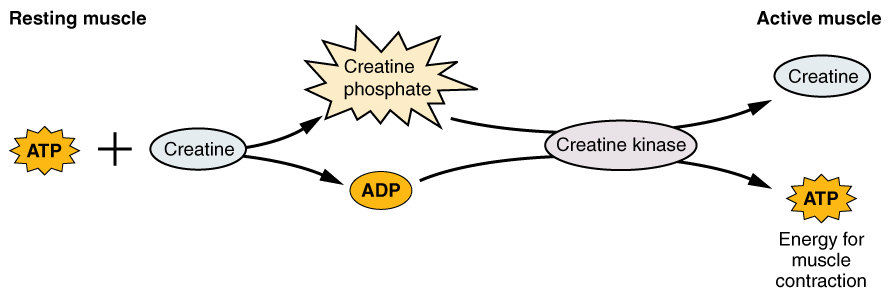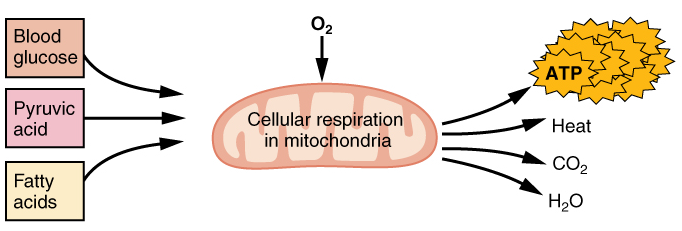Muscular Energy Needs
Every time the sarcomeres contract during the sliding filament mechanism, energy in the form of ATP is required. Review by thinking about which steps needed the ATP….
As you reviewed you could see ATP is required to detach the actin and myosin filaments and to move the myosin head back into the ready position so that another cycle of Sliding Filament can occur. Much like rowing a boat would cause you to expend energy so does this cycle. ATP is also needed to actively pump calcium back into the sarcoplasmic reticulum when contraction has ended so that the muscle can now relax. But where does all of the energy come from?
The amount of ATP that can be stored in the skeletal muscle cell itself is very low because of the chemical stability of ATP and the osmotic contribution of this molecule affecting homeostasis. There is in fact only enough ATP being stored in the skeletal muscle cells to power only a few seconds of activity, 8 muscle twitches to be exact. A muscle twitch is one contraction/relaxation cycle. We often need much more energy than this to sustain a movement to rather than trying to figure out how to store more ATP in the cell, the cell can simply regenerate ATP from its readily available ADP. ADP is adenosine diphosphate and only needs a phosphate group added to it to create adenosine triphosphate which is ATP (2 + 1 = 3 phosphate groups). Therefore, it is much easier and faster to simply regenerate ATP than to work out the logistics of how to store more of it. There are 3 mechanisms that exist in the skeletal muscle cell by which ATP can be regenerated: creatine phosphate metabolism, anaerobic glycolysis/fermentation and aerobic respiration.
Creatine phosphate is a molecule that can store energy in its phosphate bonds. In a resting muscle, excess ATP transfers its energy to creatine, producing ADP and creatine phosphate. This acts as an energy reserve that can be used to quickly create more ATP. When the muscle starts to contract and needs energy, creatine phosphate transfers its phosphate back to ADP to form ATP and creatine. This reaction is catalyzed by the enzyme creatine kinase and occurs very quickly; thus, creatine phosphate-derived ATP powers the first few seconds of muscle contraction. However, creatine phosphate can only provide approximately 15 seconds worth of energy, at which point another energy source has to be used.

Figure 12. Some ATP is stored in a resting muscle. As contraction starts, it is used up in seconds. More ATP is generated from creatine phosphate for about 15 seconds.
As the ATP produced by creatine phosphate is depleted, muscles turn to glycolysis as an ATP source. Glycolysis is an anaerobic (non-oxygen-dependent) process that breaks down glucose (sugar) to produce ATP; however, glycolysis cannot generate ATP as quickly as creatine phosphate. Thus, the switch to glycolysis results in a slower rate of ATP availability to the muscle. The sugar used in glycolysis can be provided by blood glucose or by metabolizing glycogen that is stored in the muscle. The breakdown of one glucose molecule produces two ATP and two molecules of pyruvic acid, which can be used in aerobic respiration or when oxygen levels are low, converted to lactic acid.
If oxygen is not available, pyruvic acid is converted to lactic acid, which may contribute to muscle fatigue. This occurs during strenuous exercise when high amounts of energy are needed but oxygen cannot be sufficiently delivered to muscle. Glycolysis itself cannot be sustained for very long (approximately 1 minute of muscle activity), but it is useful in facilitating short bursts of high-intensity output. This is because glycolysis does not utilize glucose very efficiently, producing a net gain of two ATPs per molecule of glucose, and the end product of lactic acid, which may contribute to muscle fatigue as it accumulates.

Figure 13. Each glucose molecule produces two ATP and two molecules of pyruvic acid, which can be used in aerobic respiration or converted to lactic acid. If oxygen is not available, pyruvic acid is converted to lactic acid, which may contribute to muscle fatigue. This occurs during strenuous exercise when high amounts of energy are needed but oxygen cannot be sufficiently delivered to muscle.
If oxygen is available, pyruvic acid is used in aerobic respiration. Aerobic respiration is the breakdown of glucose or other nutrients in the presence of oxygen (O2) to produce carbon dioxide, water, and ATP. Approximately 95 percent of the ATP required for resting or moderately active muscles is provided by aerobic respiration, which takes place in mitochondria. The inputs for aerobic respiration include glucose circulating in the bloodstream, pyruvic acid, and fatty acids. Aerobic respiration is much more efficient than anaerobic glycolysis, producing approximately 36 ATPs per molecule of glucose versus four from glycolysis. However, aerobic respiration cannot be sustained without a steady supply of O2 to the skeletal muscle and is much slower. To compensate, muscles store small amount of excess oxygen in proteins call myoglobin, allowing for more efficient muscle contractions and less fatigue. Aerobic training also increases the efficiency of the circulatory system so that O2 can be supplied to the muscles for longer periods of time.

Figure 14. Aerobic respiration is the breakdown of glucose in the presence of oxygen (O2) to produce carbon dioxide, water, and ATP. Approximately 95 percent of the ATP required for resting or moderately active muscles is provided by aerobic respiration, which takes place in mitochondria.
Muscle fatigue occurs when a muscle can no longer contract in response to signals from the nervous system. The exact causes of muscle fatigue are not fully known, although certain factors have been correlated with the decreased muscle contraction that occurs during fatigue. ATP is needed for normal muscle contraction, and as ATP reserves are reduced, muscle function may decline. This may be more of a factor in brief, intense muscle output rather than sustained, lower intensity efforts. Lactic acid buildup may lower intracellular pH, affecting enzyme and protein activity. Imbalances in Na+ and K+ levels as a result of membrane depolarization may disrupt Ca2+ flow out of the SR. Long periods of sustained exercise may damage the SR and the sarcolemma, resulting in impaired Ca2+ regulation.
Intense muscle activity results in an oxygen debt, which is the amount of oxygen needed to compensate for ATP produced without oxygen during muscle contraction. Oxygen is required to restore ATP and creatine phosphate levels, convert lactic acid to pyruvic acid, and, in the liver, to convert lactic acid into glucose or glycogen. Other systems used during exercise also require oxygen, and all of these combined processes result in the increased breathing rate that occurs after exercise. Until the oxygen debt has been met, oxygen intake is elevated, even after exercise has stopped (as when you breathe more heavily after climbing even a flight or two of stairs). You can think of oxygen debt like any other debt, i.e. a credit card. If you don't pay your balance on the credit card there are collectors that begin to come after you until you pay or they seize your assets. When you exercise and use a great deal of oxygen you still produce lactic acid in muscles that were unable to get sufficient oxygen. That lactic acid becomes the collector that begins to hound you with fatigue, cramps, or headaches until you bring in enough oxygen to convert that lactic acid into pyruvate. When the lactic acid is gone so is your debt. You can replenish oxygen in various ways such as stretching to increase circulation or even drinking lots of water since H2O has oxygen. Depending on the intensity of the workout it could take hours or days to replenish this debt.


